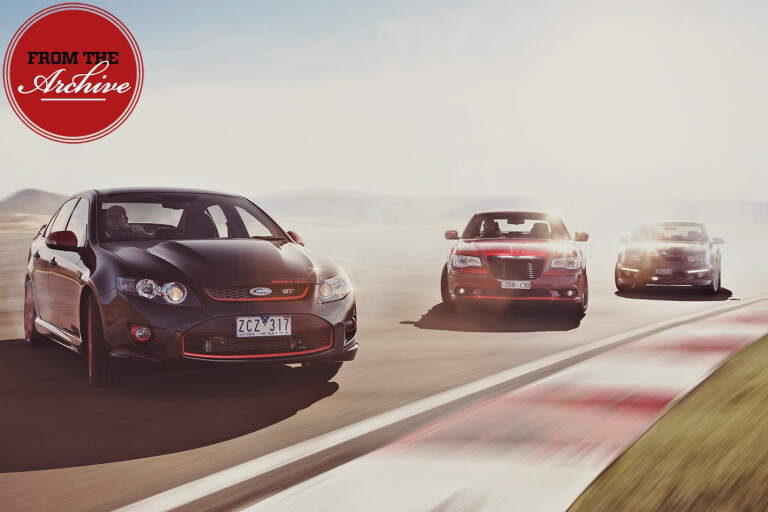
First published in the October 2012 issue of Wheels magazine, Australia's best car mag since 1953.
They each pack enough firepower to shred the treads, but only one can truly lay claim to being Australia’s fastest car.
FOUR POINT something. That’s all I want the Vbox display to spit out after numerous, often-frustrating runs at Eastern Creek’s sticky dragway in the new, hard-core FPV GT R-Spec.
Only once have I managed to muscle an Aussie-built car under the five-second bracket – a 4.99 fluke in an HSV GTO Coupe about six years ago. The best I’ve managed from an FPV was a 5.00 in a 310kW F6 auto. As for best-ever Aussie car acceleration data, Wheels’ Jonathan Hawley once ripped a 4.7sec 0-100km/h out of a 7.0-litre, 375kW HSV W427 on his way to a 12.8sec 0-400 metre pass. That was in August 2008, and nothing, especially not FPV’s supercharged but traction-limited GT, has since come close.
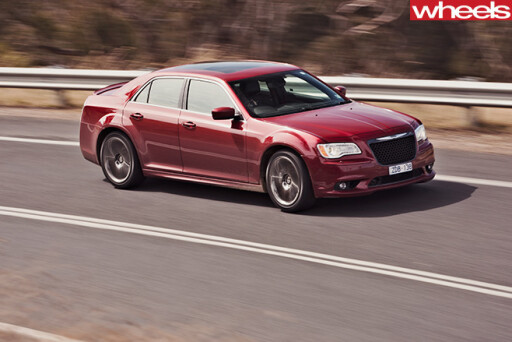 Accelerative bragging rights have been the big thing in Australian car culture ever since Ford stuffed a 4.7-litre V8 in an XR Falcon back in 1967 and GT owners suddenly found themselves arriving at the end of the quarter mile a second quicker than their Holden-driving counterparts. Ford’s dominance of the strip peaked with the GT HO in Phase II (XW) and III (XY) guises, when these 351 Cleveland-powered monsters would nail 60mph (96.5km/h) in 6.1sec and the quarter mile in 14.4. Over the last 40 years, however, Blue Oval fans have suffered through long droughts of playing second fiddle to the latest and greatest from The General.
Accelerative bragging rights have been the big thing in Australian car culture ever since Ford stuffed a 4.7-litre V8 in an XR Falcon back in 1967 and GT owners suddenly found themselves arriving at the end of the quarter mile a second quicker than their Holden-driving counterparts. Ford’s dominance of the strip peaked with the GT HO in Phase II (XW) and III (XY) guises, when these 351 Cleveland-powered monsters would nail 60mph (96.5km/h) in 6.1sec and the quarter mile in 14.4. Over the last 40 years, however, Blue Oval fans have suffered through long droughts of playing second fiddle to the latest and greatest from The General.
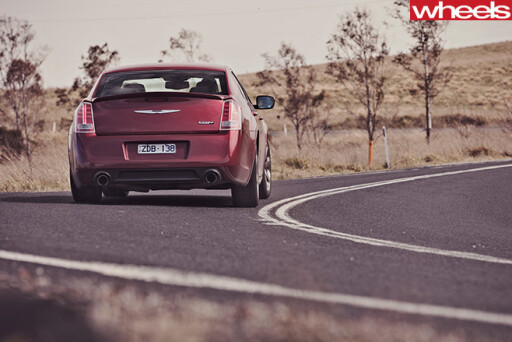 The problem for the current crop of FPVs, both turbo six and supercharged eight, is traction – or lack of it. Even after HSV made the 2006 switch to wider (275) rear rubber, FPV insisted on feeding ever-increasing slugs of forced-induction power and torque through 245 hoops. But finally, Eureka, hallelujah and all that, the R-Spec GT, among myriad tweaks, attempts to harness its grunt with 275/30 ZR19 Dunlop SP Sport Maxx rear rubber. Add a sophisticated launch control system (standard on both auto and manual R-Spec Falcons) and the FPV has serious potential to become Australia’s fastest car.
The problem for the current crop of FPVs, both turbo six and supercharged eight, is traction – or lack of it. Even after HSV made the 2006 switch to wider (275) rear rubber, FPV insisted on feeding ever-increasing slugs of forced-induction power and torque through 245 hoops. But finally, Eureka, hallelujah and all that, the R-Spec GT, among myriad tweaks, attempts to harness its grunt with 275/30 ZR19 Dunlop SP Sport Maxx rear rubber. Add a sophisticated launch control system (standard on both auto and manual R-Spec Falcons) and the FPV has serious potential to become Australia’s fastest car.
Prior to testing the FPV, either as a way to build tension or to prolong the disappointment if the R-Spec couldn’t do the number, I first run the Chrysler 300 SRT8 (they’ve dropped the C) and HSV’s Clubsport R8.
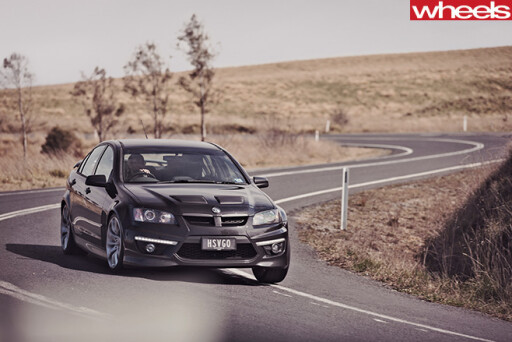 Available with only a five-speed auto (an eight-speed auto will arrive next year), the 347kW/631Nm 6.4-litre V8 Chrysler is the easiest car of this trio from which to extract a set of decent numbers. But so refined is the new SRT8 (more on this later) it’s difficult to judge the onset of time-sapping wheelspin. In fact, so quiet is the big American that I’ve no idea of its outright pace. The onboard data logger (which also shows G-force, power, torque and lap times) suggests the last run was a 12.6 second for the 0-400 metre dash. Swapping the memory card into the laptop to download the Vbox confirms the pace of the SRT8 at 4.8sec to 100km/h and 12.9 across the standing 400 metres. Perhaps there really is no replacement for displacement.
Available with only a five-speed auto (an eight-speed auto will arrive next year), the 347kW/631Nm 6.4-litre V8 Chrysler is the easiest car of this trio from which to extract a set of decent numbers. But so refined is the new SRT8 (more on this later) it’s difficult to judge the onset of time-sapping wheelspin. In fact, so quiet is the big American that I’ve no idea of its outright pace. The onboard data logger (which also shows G-force, power, torque and lap times) suggests the last run was a 12.6 second for the 0-400 metre dash. Swapping the memory card into the laptop to download the Vbox confirms the pace of the SRT8 at 4.8sec to 100km/h and 12.9 across the standing 400 metres. Perhaps there really is no replacement for displacement.
The six-speed manual Clubsport R8, which in HSV 25th Anniversary guise now gets the 325kW V8 once reserved for the GTS, takes a great deal more finesse to launch, either using the Competition Mode launch control or when flying solo. Curiously, the launch control function doesn’t deliver either consistency or fast times so our quickest runs are with everything switched off. Despite all that power, torque and capacity, you ride a knife’s edge of revs to avoid bogging the engine down, or overwhelming the rear tyres. A dozen frustrating runs, split between both myself and fellow tester Dan DeGasperi, leaves the Clubsport’s best on the day at 5.3sec to 100km/h and 13.4sec 0-400m.
 With excuses exhausted, I can no longer delay the glory or disappointment of the FPV’s performance data, and the Vbox is plugged in. There’s plenty of rubber down through the staging area and I ensure the FPV’s fat rear tyres are kissing the launch lines left by the Clubsport and Chrysler.
With excuses exhausted, I can no longer delay the glory or disappointment of the FPV’s performance data, and the Vbox is plugged in. There’s plenty of rubber down through the staging area and I ensure the FPV’s fat rear tyres are kissing the launch lines left by the Clubsport and Chrysler.
The R-Spec’s launch control engages only when stability and launch control is on, though the car does launch hard with ESC switched off. Depress the clutch, engage first gear and apply wide-open throttle. The whine of the supercharger is barely audible as the V8 booms and stutters with the revs settling to around 3200rpm. Drop the clutch, and the ECU massages torque but there’s still some wheelspin, though the extra bite from the wider tyres is immediately noticeable as first is swallowed in a blur of serious thrust. Second needs to be muscled home and, despite ESC being active, there’s a burst of wheelspin as the supercharger applies its blowtorch again. The crossgate shift to third is hit and miss (I miss three times in eight runs) but get it right and there’s another staccato chirp from the rear Dunlops. There’s a final protest from the tyres as fourth is needed just before the 400-metre timing marker.
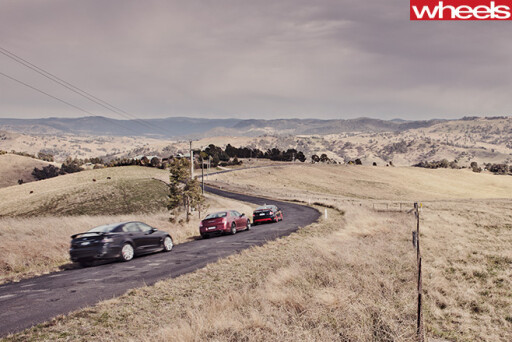 That last run felt quick, so it’s time to plug in the memory card and learn where the R-Spec sits in Australia’s pantheon of pace. The numbers cascade down the laptop’s screen as the heat wrinkles the air around the ticking and tonking GT behind me. There are lots of fours and lots of 12s but it takes a while for the numbers to coalesce into something comprehensible. That last run included a 4.57sec sprint to 100km/h and a 12.64sec standing 400m at a terminal speed of 189km/h. For old-school guys, the 0-160km/h (100mph) time was 9.8sec. But the bitch of it is that one of the aborted runs netted a 4.52sec 0-100km/h, so the car is capable of more. In every measurable way, the GT R-Spec is the fastest-accelerating car to ever roll out of an Aussie factory (and we have a suspicion that an auto R-Spec could go quicker again).
That last run felt quick, so it’s time to plug in the memory card and learn where the R-Spec sits in Australia’s pantheon of pace. The numbers cascade down the laptop’s screen as the heat wrinkles the air around the ticking and tonking GT behind me. There are lots of fours and lots of 12s but it takes a while for the numbers to coalesce into something comprehensible. That last run included a 4.57sec sprint to 100km/h and a 12.64sec standing 400m at a terminal speed of 189km/h. For old-school guys, the 0-160km/h (100mph) time was 9.8sec. But the bitch of it is that one of the aborted runs netted a 4.52sec 0-100km/h, so the car is capable of more. In every measurable way, the GT R-Spec is the fastest-accelerating car to ever roll out of an Aussie factory (and we have a suspicion that an auto R-Spec could go quicker again).
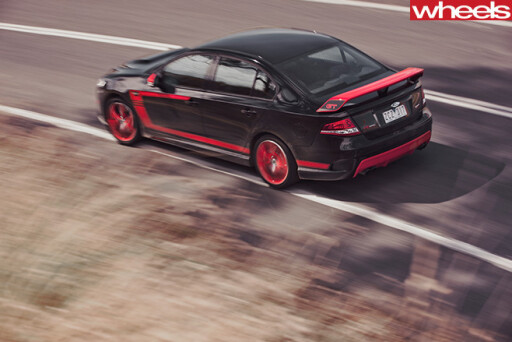 Even without this crushing dragstrip supremacy, to say that the R-Spec has been highly anticipated is like asking the rhetorical question about Catholic bears pooping in the woods. Here is a 30-minute snapshot of my time with it. Collect car and drive 6km to a servo to top the tank. I’m approached by a Ford Falcon XR6 Turbo driver who is so excited to be in the presence of the R-Spec he spits on me. Repeatedly. Depart servo slightly damp, and drive straight into Random Breath Testing station. Cop one is all business; licence, count to 10. But cop two doesn’t bother trying to hide his enthusiasm, telling me about the nine-inch wide rear wheels, the launch control system and the stiffer suspension. He then offers a straight swap for his Highway Patrol car. I know in which car I could have more fun. From the cops to a cabbie five minutes down the road, who suggested the R-Spec was “sex on wheels”, the R-spec continued to draw looks and comments for the next three days. At one point, with a Commodore SS ute and another FPV GT in tow, I felt like the Pied Piper of Aussie muscle.
Even without this crushing dragstrip supremacy, to say that the R-Spec has been highly anticipated is like asking the rhetorical question about Catholic bears pooping in the woods. Here is a 30-minute snapshot of my time with it. Collect car and drive 6km to a servo to top the tank. I’m approached by a Ford Falcon XR6 Turbo driver who is so excited to be in the presence of the R-Spec he spits on me. Repeatedly. Depart servo slightly damp, and drive straight into Random Breath Testing station. Cop one is all business; licence, count to 10. But cop two doesn’t bother trying to hide his enthusiasm, telling me about the nine-inch wide rear wheels, the launch control system and the stiffer suspension. He then offers a straight swap for his Highway Patrol car. I know in which car I could have more fun. From the cops to a cabbie five minutes down the road, who suggested the R-Spec was “sex on wheels”, the R-spec continued to draw looks and comments for the next three days. At one point, with a Commodore SS ute and another FPV GT in tow, I felt like the Pied Piper of Aussie muscle.
 Aside from the wider rear rubber and launch control, the R-Spec brings 45 percent firmer rear spring rates, with retuned ZF Sachs dampers. The 19mm rear anti-roll bar is 1mm thicker and there are revised rear toe settings. Up front, the upper control arm bushes are 40 percent stiffer and the strut mounts are 60 percent more taut. But it’s the transmission mounts which have been given the biggest dose of Viagra. Those on the auto are 150 percent stiffer while those on the manual are 190 percent less flaccid.
Aside from the wider rear rubber and launch control, the R-Spec brings 45 percent firmer rear spring rates, with retuned ZF Sachs dampers. The 19mm rear anti-roll bar is 1mm thicker and there are revised rear toe settings. Up front, the upper control arm bushes are 40 percent stiffer and the strut mounts are 60 percent more taut. But it’s the transmission mounts which have been given the biggest dose of Viagra. Those on the auto are 150 percent stiffer while those on the manual are 190 percent less flaccid.
Not only are these changes designed to deliver faster times at the strip, but they are about making the R-Spec a pointier, better-controlled muscle car on backroads and racetrack. FPV says the changes and associated R&D work cost $4 million. Though there’s no official word yet, the company will obviously look to amortise that cost over more than the 350 R-Specs it plans to build (most of which will be sold by the time you read this).
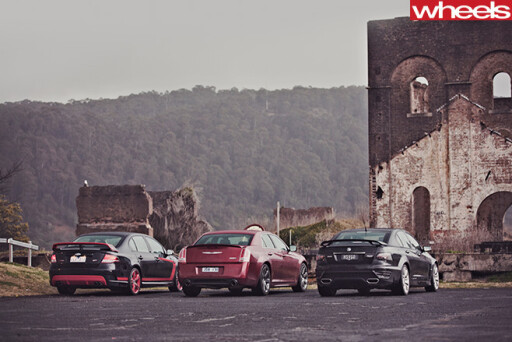 Regardless of transmission, the FPV GT R-Spec will set you back $76,990 plus on-road costs. Thankfully only half the 350-unit run will be in the ‘hero’ combo of Silhouette (black) and Vixen (red) – which is meant to evoke memories of the 1969 Boss Mustang but I reckon looks like the latest offering from Hot Wheels. If you prefer a less extroverted look, the R-Spec is available in blue, white or red (all with black contrasts).
Regardless of transmission, the FPV GT R-Spec will set you back $76,990 plus on-road costs. Thankfully only half the 350-unit run will be in the ‘hero’ combo of Silhouette (black) and Vixen (red) – which is meant to evoke memories of the 1969 Boss Mustang but I reckon looks like the latest offering from Hot Wheels. If you prefer a less extroverted look, the R-Spec is available in blue, white or red (all with black contrasts).
Some may question why FPV’s biggest gun is being matched against the $71,500 Clubsport R8 but there’s a simple, non-conspiracy-theorist explanation. Until HSV announces its plans for a 25th-anniversary GTS model (expected mid-October), the now-325kW Clubsport R8 is the brand’s biggest hitter. Fitted with 20-inch wheels, bi-modal exhaust and HSV’s Enhanced Driver Interface (EDI) system, the R8 lacks only the GTS’s superb Magnetic Ride Control suspension, relying instead on good old-fashioned steel springs and hydraulic dampers.
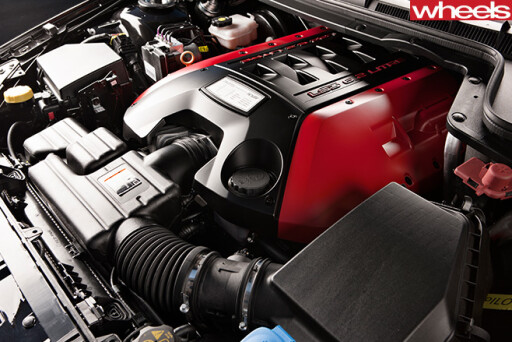 Chrysler’s dropped the C from its second-generation 300 SRT8, but elsewhere it’s added capacity, power, refinement, equipment and desirability. All while lopping the price to $66,000. The styling has lost a little of the original’s swagger but the big (5089mm, 1893kg) SRT8 remains a head-turner. Oddly, given this is an American car we’re talking about, the Chrysler’s comprehensively equipped interior is a real highlight. It’s no Audi, but the design, material and quality of the SRT8’s cabin shames the plasticky mismatch of both the locals (which are screaming out for an upgrade).
Chrysler’s dropped the C from its second-generation 300 SRT8, but elsewhere it’s added capacity, power, refinement, equipment and desirability. All while lopping the price to $66,000. The styling has lost a little of the original’s swagger but the big (5089mm, 1893kg) SRT8 remains a head-turner. Oddly, given this is an American car we’re talking about, the Chrysler’s comprehensively equipped interior is a real highlight. It’s no Audi, but the design, material and quality of the SRT8’s cabin shames the plasticky mismatch of both the locals (which are screaming out for an upgrade).
The previous-generation SRT8 was an aloof handler with a brittle ride and while the new car is hardly the last word on involvement, it rides with real aplomb. And it exudes a level of refinement that frankly embarrasses the two locals. When cruising, and regardless of road surface, there’s minimal engine or road noise, which tricks you into thinking you’re not going quick – you are. The steering is still numb and the wheel on our test example moaned softly as you turned hard to the right. With 245/45 ZR20 Goodyear Eagle F1 Supercar tyres at both ends, the SRT8 actually has the narrowest rear tyres on test. The Chrysler’s refinement and lack of feedback hinders your ability to detect the onset of under- or oversteer. Really push and there’s some rack rattle over mid-corner bumps.
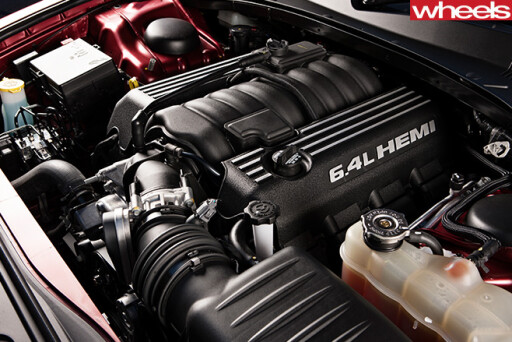 The sheer size and bulk of the car, combined with the gun-slit view from the driver’s seat, can intimidate on twisty roads. Huge brakes (360mm front and 350mm rear) deliver tireless performance, but after an inch of soft travel, the pedal bites and the anchors give all they have. Drive tensely with abrupt inputs and the Chrysler makes halting progress. Relax and the car relaxes with you. Despite its pace, there’s little chance of spotting an SRT8 at a track day (as you might an FPV or HSV). But if you’re after a boulevard cruiser and flowing backroad bruiser, the American is a real winner.
The sheer size and bulk of the car, combined with the gun-slit view from the driver’s seat, can intimidate on twisty roads. Huge brakes (360mm front and 350mm rear) deliver tireless performance, but after an inch of soft travel, the pedal bites and the anchors give all they have. Drive tensely with abrupt inputs and the Chrysler makes halting progress. Relax and the car relaxes with you. Despite its pace, there’s little chance of spotting an SRT8 at a track day (as you might an FPV or HSV). But if you’re after a boulevard cruiser and flowing backroad bruiser, the American is a real winner.
Get deep into the rev range and the once-mute Hemi finds its voice. Disappointingly, though, the big V8 lacks the throttle response of the Aussie pair but the five-speed auto isn’t the handicap you might expect. Actually, it suits the cruisey, bruisey nature of the Chrysler. The new eight-speed auto will address the slow shifts (both up and down), and a wider spread of ratios will allow the engine to make better use of its torque.
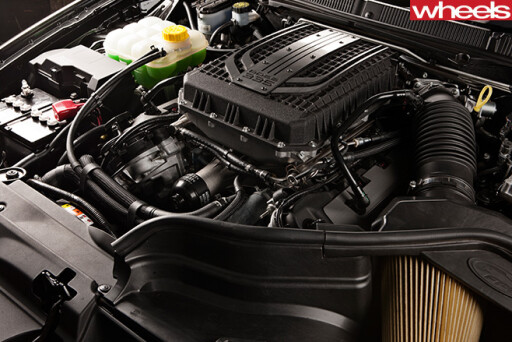 Away from the dragstrip, the FPV’s supremacy quickly crumbles. As a manual, it’s not an easy car to drive and you need to balance stalling the 5.0-litre V8 or over-revving it like a learner or a loser. The shift itself is slow, heavy and baulky even when you’re not trying to rush it like on the strip. Maybe it was the low kays of our test example but the effort to shift this six-speeder is one reason car companies and consumers are turning away from H-pattern manuals.
Away from the dragstrip, the FPV’s supremacy quickly crumbles. As a manual, it’s not an easy car to drive and you need to balance stalling the 5.0-litre V8 or over-revving it like a learner or a loser. The shift itself is slow, heavy and baulky even when you’re not trying to rush it like on the strip. Maybe it was the low kays of our test example but the effort to shift this six-speeder is one reason car companies and consumers are turning away from H-pattern manuals.
Thankfully, that monster supercharged V8 can cover the many deficiencies of the gearbox and the three-four plane is all you need on anything but the tightest roads. The supercharger whine comes on strong from 2500rpm with maximum torque (nominally 575Nm) available across a plateau from 2200-5500rpm. FPV admits that the blower will overboost and the true torque figure is in the 600s. And the autokW at 5750rpm also feels a bit modest.
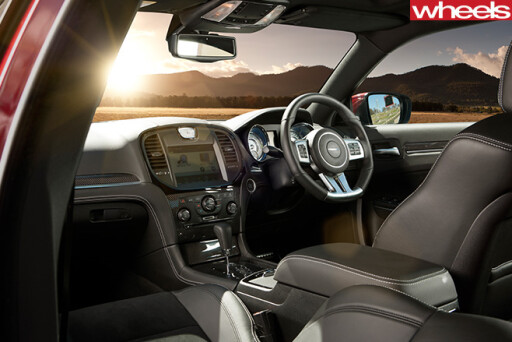 FPV suggests this is their most sophisticated product yet and, with specific reference to the suspension modifications, admits it’s the car they should have delivered when it first fitted the supercharged Miami V8 to the FG back in 2010. The firmer body control banishes the float that makes it difficult to punt a GT or F6 with confidence. But when you’re not in max-attack mode, the loss of ride compliance begins to grate.
FPV suggests this is their most sophisticated product yet and, with specific reference to the suspension modifications, admits it’s the car they should have delivered when it first fitted the supercharged Miami V8 to the FG back in 2010. The firmer body control banishes the float that makes it difficult to punt a GT or F6 with confidence. But when you’re not in max-attack mode, the loss of ride compliance begins to grate.
The firmness of the rear needs to be recognised and treated with caution when cornering on anything but smooth tarmac. Striking a mid-corner bump with either the loaded outside, or unladen rear tyre has the big Falcon skipping sideways. And at 1855kg, that’s a lot of Falcon to catch.
The suspension changes make the R-Spec’s steering keener, but it still can’t match the fluid feedback from the HSV’s steering.
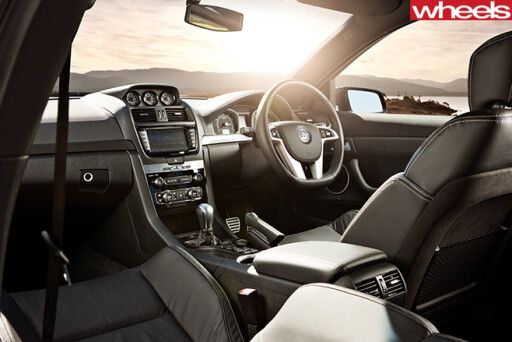 In 1971, Wheels road tested the Ford Falcon GT-HO Phase III under the headline, ‘The Biggest Stick’. Today’s GT R-Spec is indeed the biggest stick, but instead of being a pointy, finely honed instrument (of this trio only the Clubsport begins to approach that description) the R-Spec remains a blunt, but effective, weapon.
In 1971, Wheels road tested the Ford Falcon GT-HO Phase III under the headline, ‘The Biggest Stick’. Today’s GT R-Spec is indeed the biggest stick, but instead of being a pointy, finely honed instrument (of this trio only the Clubsport begins to approach that description) the R-Spec remains a blunt, but effective, weapon.
Don’t get me wrong, the R-Spec is a devastatingly fast car and can cover ground at lock-me-up speeds. But it lacks any sort of precision or finesse and feels old-school and aftermarket. Of course, none of this will matter to those who will insist the GT is the best car, or those who’ll lock theirs away hoping for a big payday in a decade’s time. And that’s fine. But the brash FPV makes me wonder whether either the Aussie car enthusiast or Aussie hotshop has moved on since the days of flares, panel vans and the Hardie Ferodo 500.
The Clubsport, the least powerful and slowest car here in a straight line, remains the most engaging on a twisty road – and I’d wager would not give away much, if anything, to the R-Spec on a racetrack.
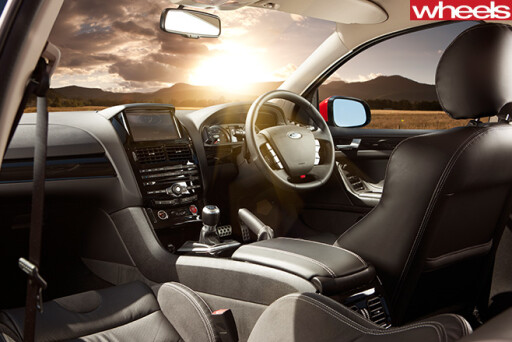 Like the FPV, the hot Holden is very firm and the Clubsport lacks the subtlety of the MRC-equipped HSV GTS. But dynamically only the HSV really knows any answers. The Chrysler is so aloof that even if it knows the score, it refuses to speak up. Sometimes the FPV answers correctly but other times the new-found firmness ties it in knots.
Like the FPV, the hot Holden is very firm and the Clubsport lacks the subtlety of the MRC-equipped HSV GTS. But dynamically only the HSV really knows any answers. The Chrysler is so aloof that even if it knows the score, it refuses to speak up. Sometimes the FPV answers correctly but other times the new-found firmness ties it in knots.
There’s proper feedback from the HSV’s slightly too-large steering wheel and you can lean on either end with confidence. And the linear power delivery of the 6.2-litre V8 allows you to measure out exactly one Newton metre less than what the rear 275/30 R20 Bridgestones can handle.
The R8’s V8 crackles and booms on the overrun and at night you can see the flash as the occasional flame pops from the exhausts. It sounds 50kW stronger than its 325kW output and the crisp throttle response cannot be matched by the Chrysler and FPV. In turn, the HSV can’t match the SRT8’s bigger-capacity punch through the mid-range, nor can it keep up with the seismic shove of the FPV. The six-speed manual shifts faster than the manual in the R-Spec and with significantly less effort.
So the HSV wins, by being fast enough, and because it’s got a proper, playful chassis; a virtue that the improved R-Spec still lacks. If the salivating XR6 Turbo owner reads this result, I suspect I might get spat on again. This time he’ll mean it.
Engine rooms
Two big-capacity atmo V8s and one smaller blown engine, but three distinct characters. The 6.2-litre pushrod HSV revs hard; the supercharged 5.0-litre FPV V8 has a linear mid-range; the 6.4-litre Hemi SRT8 feels reluctant through the middle revs. Chrysler claims the Hemi is 6424cc, but if you work out swept capacity from the supplied 103.9mm bore and 94.5mm stroke, you get 6410cc. Curious.

HSV CLUBSPORT R8
Price as tested: $71,990
Engine: V8 (90°), ohv, 16v
Capacity: 6.162 litres
Transmission: 6-speed manual
Power: 325kW @ 6000rpm
Torque: 550Nm @ 4600rpm
Power to weight: 179kW/tonne
O-1OOkm/h: 5.3sec
Fuel consumption: 13.5L/100km (ADR81/02)
NCAP rating: 5 stars (ANCAP)
Plus: Fluid steering; crisp throttle response; balanced handling
Minus: Interior feels very dated; not super fast; taut ride
Verdict: 8.0/10

FPV GT R-SPEC
Price as tested: $76,990
Engine: V8 (90°), dohc, 32v, supercharged
Capacity: 4.951 litres
Transmission: 6-speed manual
Power: autokW @ 5750rpm
Torque: 575Nm @ 2200-5500rpm
Power to weight: 181kW/tonne
O-1OOkm/h: 4.6sec
Fuel consumption: 13.6L/100km (ADR81/02)
NCAP rating: 5 stars (ANCAP)
Plus: Fastest-accelerating Aussie car ever; sweet supercharger whine
Minus: Updated chassis still lacks finesse; firm ride; interior quality
Verdict: 7.0/10

CHRYSLER 300 SRT8
Price as tested: $66,000
Engine: V8 (90°), ohv, 16v
Capacity: 6.410 litres
Transmission: 5-speed automatic
Power: 347kW @ 6100rpm
Torque: 631Nm @ 4150rpm
Power to weight: 183kW/tonne
O-1OOkm/h: 4.8sec
Fuel consumption: 13.0L/100km (ADR81/02)
NCAP rating: 5 stars (NTSB)
Plus: Interior design and quality; refinement; surprising pace
Minus: All controls lack feedback; interior and boot not hugely spacious
Verdict: 7.0/10

COMMENTS